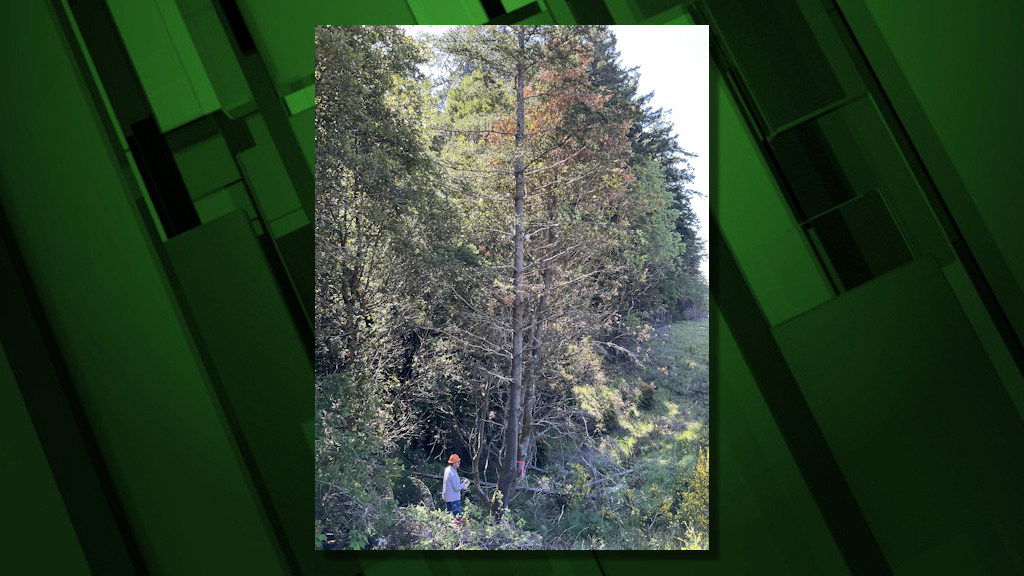Second sudden oak death infection site found in SW Oregon

PORT ORFORD, Ore. (KTVZ) – A second site where tanoaks have been found infected with the sudden oak death pathogen was detected 21 miles northwest of the existing quarantine area for the tree disease in southern Oregon's Curry County, the Oregon Department of Forestry said Tuesday.
On April 27, an OSU researcher driving back from Brookings noticed dying tanoaks along Highway 101 just outside Port Orford. She stopped and collected samples, which tested positive on May 10 at the OSU Forest Pathology Lab in Corvallis for Phytophthora ramorum, which causes sudden oak death. The pathogen can infect many plants but kills tanoaks.
The new site’s discovery comes just as cutting and piling of tanoaks at a site on the north bank of the Rogue River was completed. That site was discovered earlier this spring in the Rogue River-Siskiyou National Forest. Five tanoaks were found there to be infected with the EU1 strain of P. ramorum. To prevent spores from spreading the disease, all tanoaks near where infected trees were found were cut, piled and will be burned later this year.
Both sites are in Curry County but beyond the current 515-square-mile SOD quarantine area. The first site is near the Myrtle Tree Trail and about six miles north of the nearest previously known sudden oak death infestation. It has been determined that no public recreation restrictions will be necessary while treating this area. The second site is 13 miles south of Coos County.
Following federal protocol, the samples from the second site will be sent from OSU to the Oregon Department of Agriculture’s Plant Health Lab in Salem for confirmatory testing. If positive the samples will be shipped to the U.S. Department of Agriculture’s Animal and Plant Health Inspection Service Lab in Maryland for final confirmation. New infestation sites must be confirmed by APHIS’ Plant Protection Quarantine unit before regulatory action may take place. Lab tests are still being done at OSU to determine the pathogen strain at the second site.
SOD crews from the Oregon Department of Forestry and the USDA Forest Service will continue to heavily monitor both areas for the presence of infested trees and plants. Both areas will also be monitored by aerial disease survey experts, with helicopter flights over northern Curry County planned.
Oregon regulations require state and private property officially confirmed as infested with SOD undergo eradication treatments. Federal and state funds are available to cover the cost of treating both infected areas. The full extent of the second site is still being determined pending surveyors being granted access to nearby private land.
ODA maintains the Phytophthora ramorum Quarantine, which allows any property in the state, including a buffer zone of up to 3 miles surrounding where a SOD infestation has been confirmed, to be placed under quarantine (OAR 603-052-1230(2)(d). Thus, a unique emergency quarantine order does not need to be issued. Oregon’s SOD Program will consult with stakeholders regarding any potential expansion of quarantine boundaries.
Background
The invasive non-native pathogen that causes the sudden oak death (SOD) in tanoak was first detected in Oregon in 2001. A plant quarantine of the area was promptly set up, which has gradually expanded to cover almost a third of Curry County. When attempts to eradicate the disease – which can survive on several native and non-native plant species – proved impossible, Oregon’s SOD program switched to slowing the spread of the disease.
In 2010, a Generally Infested Area (GIA) within the quarantine area was created. Within that zone, where the disease is well established, eradication treatments are no longer required. The GIA was enlarged in late 2020 and now covers 123 square miles within the quarantine area; it is about 19 miles north to south and nine miles east to west.
In Europe, the EU1 strain of P. ramorum has been found to damage and kill several conifer species, including Douglas-fir, western hemlock, grand fir, and larch. That strain was first found in Oregon in 2015 within the existing quarantine area. Infestations of the EU1 strain are aggressively treated with the goal of local eradication.
Read more about sudden oak death at https://www.oregon.gov/ODF/Documents/ForestBenefits/SOD.pdf.